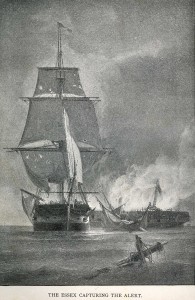One Of Our Favorite Veterans
 We’ve got a lot of veterans in our family, myself included, so we like to recognize them on Veterans’ Day. Someone asked a question recently about this particular veteran, so I thought I’d share the story today in honor of intrepid young men doing their duty all over the world!
We’ve got a lot of veterans in our family, myself included, so we like to recognize them on Veterans’ Day. Someone asked a question recently about this particular veteran, so I thought I’d share the story today in honor of intrepid young men doing their duty all over the world!
We talk about Admiral David Farragut (of “D— the torpedoes – full speed ahead!” Civil War fame) in our book and in several of our workshops. The incident below happened during the War of 1812, when he was a young midshipman on the USS Essex, sailing off the coast of South America and harrassing British vessels in the South Pacific. The practice of the time was that any ship captured in the course of war could be claimed as a prize, taken to a friendly port, and sold off as a bonus to the crew. On this cruise, the Essex had a string of successful engagements with the enemy:
By this time [Captain David Porter] had captured so many vessels that he was compelled to draw on the midshipmen for prize masters, and in the trip from Tumbez to Valparaiso, he put the ship Barclay, with her ex-captain retained on board to help navigate her, under the command of Midshipman Farragut, then not quite twelve years old. At the very outset, the lad was compelled to settle the question of command with the big whaler, who swore that he would take the Barclay to New Zealand instead of Valparaiso, and went below to get his pistols. The other vessels of the squadron were by this time too far away to communicate with, but Farragut, after telling his right hand man of the prize crew what the situation was, shouted down the cabin ladder that if the whaler came up with his pistols he did so at the risk of going overboard. Finding that the crew were ready to stand by their young commander, the ex- captain had to give in. From that moment Farragut was master of the situation and navigated the Barclay without mishap to Valparaiso.
From Capt. George Ramsey Clark, et al., A Short History of the United States Navy (Philadelphia: J. B. Lippincott, 1911), p. 178.